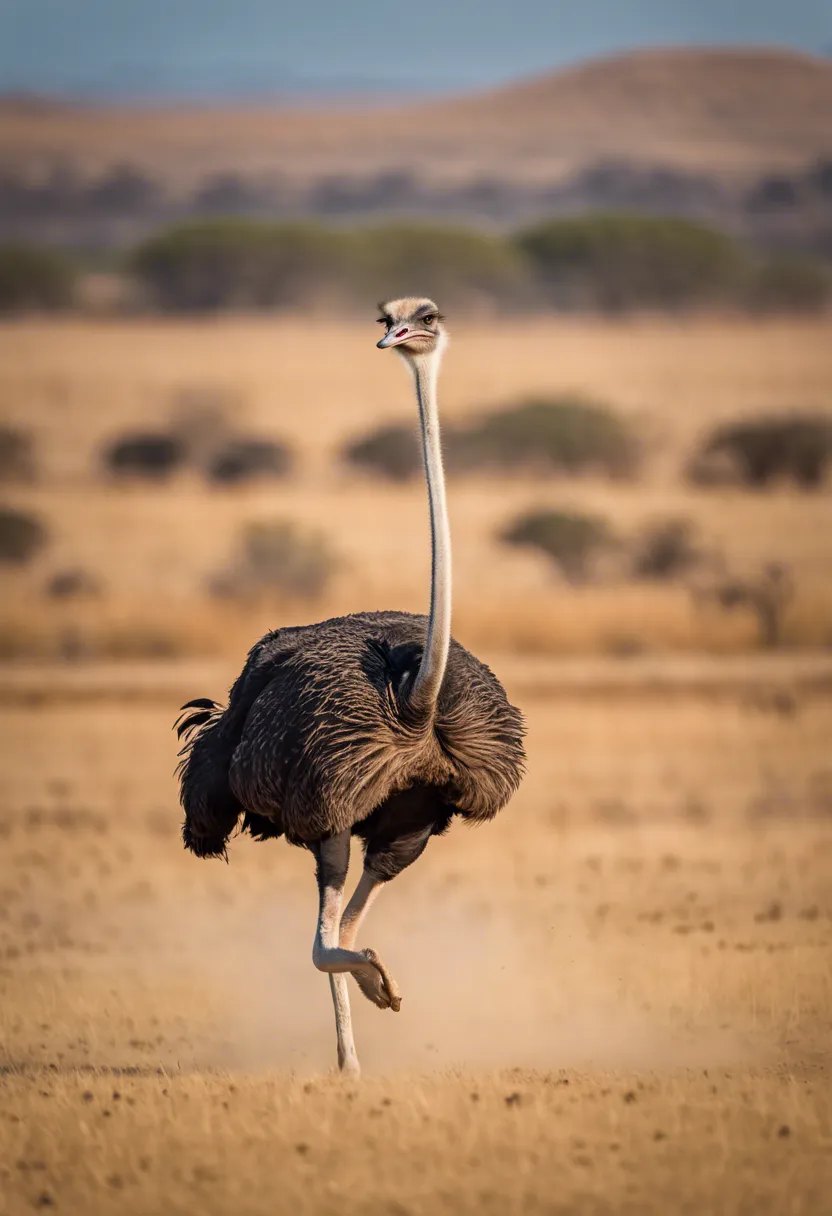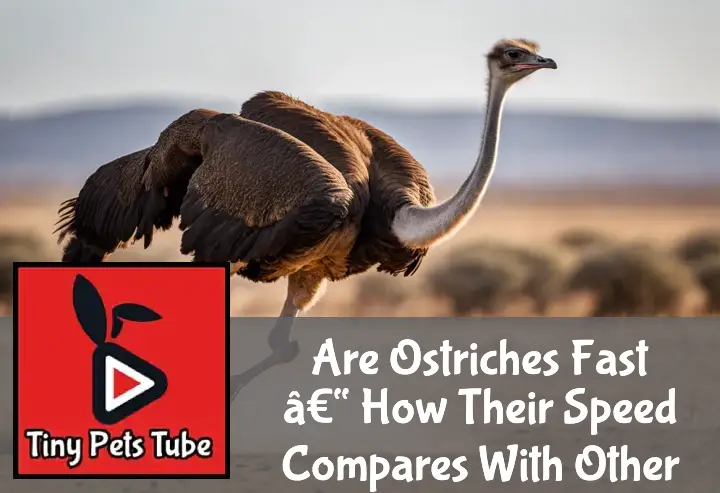Ever caught yourself wondering, “Are Ostriches Fast?” Well, you’re not alone. Many of us have found ourselves scratching our heads over this seemingly simple question. After all, how fast can a bird that doesn’t even fly be?
But hold on to your hats folks, because these feathered giants are full of surprises! They might not be soaring in the sky anytime soon, but when it comes to sprinting across the savannah, they’re practically Olympians. So buckle up and keep reading about “Are Ostriches Fast – How Their Speed Compares With Other Creatures”.
Key Takeaways
- Ostriches are the fastest birds on land, reaching speeds up to 60 mph.
- They outrun many other creatures, including horses and greyhounds.
- Their speed is attributed to their powerful legs and stride length of 10-16 feet.
- However, they fall short when compared to the fastest creatures like the peregrine falcon or cheetah.
- Despite their speed, ostriches cannot fly.

Understanding Ostriches
Ever wondered how Are Ostriches Fast? Well, it’s all in their unique build and the wild world they call home. Let’s dive into what makes these flightless birds such speedsters.
The Anatomy of an Ostrich
Ostriches are marvels of evolution, perfectly designed for speed. Their long legs aren’t just for show; they’re a key component of their ostrich speed. Each stride can cover up to 16 feet, which is like sprinting across your living room in one step! But it’s not just about leg length. The muscle composition in ostriches is fine-tuned for running. These birds pack a powerful punch with muscles that are optimized for quick, explosive movements.
The secret sauce to their speed also lies in their flightless bird anatomy. Without the need to fly, ostriches have evolved with lighter skeletons and more muscle mass dedicated to running. This combination of lightweight bones and strong muscles allows them to reach impressive speeds without breaking a sweat. Plus, their ostrich physical characteristics, like wide-set eyes and a flexible neck, help them stay alert and navigate through their environment while on the move.
Ostriches in the Wild: Habitats and Behaviors
Ostriches roam across diverse landscapes, from savannas to deserts. These varying natural habitats of ostriches play a big role in shaping their behaviors. In the vast open spaces of Africa, being fast isn’t just nice; it’s necessary for survival. Their ostrich feeding habits involve grazing on plants and insects, requiring them to cover large areas to find food.
Socially, these birds are pretty interesting too. The social behavior of ostriches includes forming flocks that can range from a few birds to over fifty during breeding season! This social structure helps them look out for each other against predators. Speaking of predators, predator avoidance in ostriches is where their speed really comes into play. When faced with danger, they can bolt at incredible speeds or use their powerful legs for defense.
Living as a flightless bird, you might think ostriches got the short end of the stick in the animal kingdom. But with their specialized anatomy and savvy survival strategies, they’ve adapted remarkably well to thrive in their environments.
How Fast Can an Ostrich Run?
When it comes to land speed records in the bird world, ostriches take the crown. They’re not just any fast bird; they’re the fastest bird on land, bar none.
Factors Influencing an Ostrich’s Speed
Ever wondered what makes these feathered speedsters tick? Well, it all starts with their ostrich leg anatomy. These legs aren’t just for show; they’re powerful pistons packed with specialized muscle structure in birds that propels them forward at astonishing speeds. But it’s not just about power. The design of their legs allows for a stride that’s both long and efficient, making every step count.
Then there’s their habitat. Ostriches hail from environments where being able to book it is pretty much a survival skill. This means that over time, they’ve evolved to become even faster, thanks to both genetic and environmental factors affecting speed. Whether it’s escaping predators or sprinting towards a meal, their surroundings have shaped them into the ultimate runners.
Comparing an Ostrich’s Speed with a Human’s
Now, let’s pit these avian athletes against us humans. On our best day, the fastest among us can hit speeds around 28 mph during a sprint. Impressive? Sure, until you learn that an ostrich can easily outpace us by clocking in at speeds up to 45 mph. That’s right; when it comes to a footrace, we’re eating dust.
This disparity isn’t just about who has longer legs (though that certainly doesn’t hurt). It boils down to fundamental physiological differences in running capabilities between humans and ostriches. While we’re built more for endurance than outright speed, these birds are designed to cover short distances incredibly quickly. So next time someone asks if are ostriches fast, you’ll know exactly how much faster they are compared to us mere mortals.

Other Fast Creatures in the Animal Kingdom

When we talk about speedsters in the animal kingdom, it’s not just Are Ostriches Fast that comes to mind. There are some real record breakers out there, from the land to the sky, and even under the sea!
Cheetahs: The Fastest Land Animals
Cheetahs are the undisputed champions of land speed records, reaching up to 75 mph in short bursts. This incredible speed is all thanks to their lean bodies and powerful leg muscles. They’re built for sprinting, using their acceleration primarily for hunting. When a cheetah spots its prey, it stealthily approaches before launching into a full-blown sprint.
Comparing these feline speed demons to ostriches is quite fascinating. While ostriches are fast, they can’t quite match the top-end speeds of cheetahs. However, ostriches have better endurance and can maintain their top speed longer than cheetahs can sustain theirs. So, in a marathon, an ostrich might just have the edge over a cheetah!
Peregrine Falcons: The Fastest Birds
Peregrine falcons take aerial speed champions to a whole new level with dive speeds exceeding 200 mph! These birds are masters of the sky, using high-speed dives to snatch prey mid-air with astonishing precision. Their streamlined bodies and strong wings make them perfect for this high-velocity hunting technique.
Now, if we pit peregrine falcons against ostriches in terms of speed, it’s apples and oranges – or should we say feathers and feet? While peregrine falcons dominate the skies with their lightning-fast dives, ostriches hold their own on land with impressive running capabilities. It’s a classic case of aerial vs terrestrial prowess.
Sailfish: The Fastest Sea Creatures
Sailfish are the marine velocity kings, slicing through water at speeds up to 68 mph. Their sleek bodies and large dorsal fins (the sail) minimize water resistance allowing them swift movements through their aquatic realm. This adaptation is crucial for both escaping predators and ambushing prey.
When comparing these sea sprinters with our feathered friends on land, it’s clear that each excels in its own element. Sailfish may rule the waves with unmatched speed among aquatic animals but put them on land next to an ostrich running at full tilt? Well, you’d have one confused fish! Ostriches’ running capability showcases how evolution has tailored each creature perfectly for its environment – whether it be land or sea.
Comparing the Speed of Ostriches with Other Animals
When it comes to speed, ostriches are no slouches. But how do they stack up against the fastest animals on land, in the air, and under the sea? Let’s dive into an ostrich speed comparison.
Speed Comparison: Ostrich vs. Cheetah
The cheetah holds the title for the fastest land animal, reaching speeds up to 75 mph in short bursts covering distances up to 1,500 feet. This is thanks to its lightweight frame, large nostrils for more oxygen intake, and a tail that acts like a rudder for sharp turns. On the other hand, ostriches can hit speeds of about 45 mph. While they might not win in a sprint, their endurance allows them to maintain high speeds longer than a cheetah can. This makes our feathered friends more like marathon runners compared to the cheetah’s sprinter profile. The cheetah hunting strategy relies on this burst of speed to catch prey before it tires out, while ostriches use their speed primarily for evasion.
Speed Comparison: Ostrich vs. Peregrine Falcon
Now let’s take it to the skies. The peregrine falcon is renowned for its diving speed, clocking in at over 240 mph as it swoops down on its prey. This incredible velocity is achieved through a streamlined body that reduces drag and powerful wing muscles for acceleration. In contrast, an ostrich’s running speed seems modest but remember – we’re comparing air vs land here! Different environments mean different adaptations; while falcons have evolved for aerial predation with high-speed dives, ostriches have developed strong legs suited for rapid terrestrial travel and evasion from predators.
Speed Comparison: Ostrich vs. Sailfish
Finally, let’s dip into aquatic territories where sailfish reign supreme with speeds of up to 68 mph underwater – making them one of the fastest marine creatures. Their slender bodies and long bills cut through water with minimal resistance, a feature known as hydrodynamic design which is crucial in overcoming water resistance efficiently. Comparatively, an ostrich’s land speed doesn’t face such challenges but instead deals with different types of friction and requires sturdy legs capable of propelling their large bodies forward swiftly on solid ground. While both animals are champions in their respective realms (terrestrial and aquatic), their adaptations highlight nature’s ingenuity in crafting species perfectly suited to their environments.

To Wrap Up
So, Are Ostriches Fast? You bet your feathers they are! These long-legged sprinters can outrun most of us on our best day and even give some creatures a run for their money.
Remember, next time you’re feeling slow as a snail, channel your inner ostrich. Embrace the speed, but don’t forget – it’s not always about being the fastest; it’s about running your own race.


